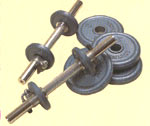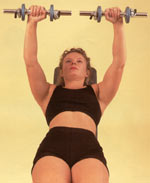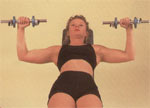|

TRAINING THE CHEST
More and more women in
body building and
fitness are discovering the benefit of a healthy, chiseled
Chest. Improving the muscle tone in the area
of the chest behind the breasts is a great way to improve the look of the bust.
It is essentially a "lift" without resorting to using a scalpel.
|
The postural alignment is basically the same
for all the chest exercises. Remember to always consciously focus and contract the muscles of the chest
while maintaining the postural alignment and form during all the chest exercises. |
There are four
areas of the chest that women
should emphasize:
Dumbbells: the best choice
 Dumbbells are recommended for performance of
chest exercises as they allow for a greater
range of motion and a deeper stretch
at the bottom of the movement. Besides they provide for a better isolation and
muscle contraction at the top of the movement, helping to recruit more muscle fibres within the chest and surrounding musculature. Dumbbells are recommended for performance of
chest exercises as they allow for a greater
range of motion and a deeper stretch
at the bottom of the movement. Besides they provide for a better isolation and
muscle contraction at the top of the movement, helping to recruit more muscle fibres within the chest and surrounding musculature.
Also, as they are harder to control and hold
than Barbell, they help to strengthen and develop the important antagonistic and
synergistic muscles of the chest and Shoulder.
Lifting the right way
The following sequence of movements will
ensure that you learn how to properly lift a dumbbell off the ground and into
position to start many of the exercises, all the way till you have completed it.
-
When picking up dumbbells make sure to bend at the knees, while you lift the
weight with your legs.
-
Lift with your legs, not with your backs! You can easily injure your lower back
by bending over to pick up the weight.
-
While standing, place the bottom plate of the dumbbells against your thighs and
keep them there as you sit on the bench seat. You will find that by keeping the
dumbbells against your thighs as you sit, it will allow you to easily manipulate
them to the top of your thighs.
-
Begin positioning your body into the correct postural alignment, starting from
the bottom of your body and moving to the top.
-
Space your feet about shoulder width apart.
-
Make sure your knees are pointing straight ahead throughout the movement.
-
As you raise the dumbbells to the starting position on top of your thighs, do not try to muscle them up with your arm muscles. This will only
drain your strength and can easily cause an
injury.
You need 100 percent of your strength for the exercise itself and cannot afford
to waste it on something that you can easily avoid. To properly raise the
dumbbells from your thighs into exercise position, follow these guidelines; you
will be using your leg muscles and momentum to help place you and the
dumbbells into position. While sitting in an upright position, with the
dumbbells on your thighs, thrust one leg up, leveraging one dumbbell up to
around your chest level.
your thighs, do not try to muscle them up with your arm muscles. This will only
drain your strength and can easily cause an
injury.
You need 100 percent of your strength for the exercise itself and cannot afford
to waste it on something that you can easily avoid. To properly raise the
dumbbells from your thighs into exercise position, follow these guidelines; you
will be using your leg muscles and momentum to help place you and the
dumbbells into position. While sitting in an upright position, with the
dumbbells on your thighs, thrust one leg up, leveraging one dumbbell up to
around your chest level.
-
Immediately thrust the second dumbbell upward, while simultaneously allowing
momentum and the dumbbells to guide you back into the lying position while your
abdominal muscles help safely ease you into the
position. The reason for lying back immediately when the second dumbbell is
thrust upward is so you do not injure your shoulder joints or lower back from
having to hold the dumbbells in that otherwise awkward position. Lying back
immediately following the dumbbell's momentum while allowing the abdominal
muscles to ease you into position will help ensure your safety and keep your
strength at its peak for the exercise. This may should difficult, but it's not.
It is the safety and easiest way of getting the dumbbells into position
(especially if you're using heavy dumbbells ).
-
Once you've gotten the dumbbells up, lay back, until your back touches the
bench.
-
The dumbbells should now be in position at the sides of your chest.
-
Again, make sure your feet are should width apart, and that they are flat on the
ground at all times.
-
Make sure your knees are straight.
-
Your lower back should be flat against the bench at all times, with no excessive
arch in the lower lumbar region (small of the back).
-
Make sure your back is flat against the bench, with the arms and elbows out to the sides and the forearms perpendicular to the floor. When
you're correctly positioned, retract or squeeze the shoulder blades together. At
first it may seem uncomfortable or odd, but do not underestimate the
significance of this technique. You must learn to hold this position throughout
the movement, and consistent practice will ensure this. By squeezing the
shoulder blades together and keeping your entire back in constant contact with
the bench, you will actually be taking the anterior shoulder out of the
exercise. The chest muscles lifting the weight.
and elbows out to the sides and the forearms perpendicular to the floor. When
you're correctly positioned, retract or squeeze the shoulder blades together. At
first it may seem uncomfortable or odd, but do not underestimate the
significance of this technique. You must learn to hold this position throughout
the movement, and consistent practice will ensure this. By squeezing the
shoulder blades together and keeping your entire back in constant contact with
the bench, you will actually be taking the anterior shoulder out of the
exercise. The chest muscles lifting the weight.
-
Relax your head throughout the movement, and make sure you do not twist it or
lift it from the bench while engaged in the exercise.
Related Articles:
top
▲
|